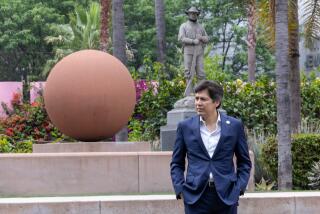Street Wise : What’s In A Name
From Easy Street to Shangri-La Drive, road names often capture hopes for the good life in the San Fernando Valley area. Others, such as Gable Drive and Trigger Street, reflect a fascination with entertainment icons. Enterprising developers have selected whole areas with streets dedicated to Native Americans, spices and artists. And thoroughfares bearing the names of animals are everywhere.
Some choices have a history. Many are the product of developers’ eccentricities.
New street names must be approved by the city’s Department of Public Works Land Development and Mapping Division, which sets specific criteria for naming streets. Historic names are encouraged, streets cannot be named after living persons, and the maximum length of a street name is 16 letters or spaces.
With more than 50,000 streets in Los Angeles County, municipal leaders are bound to run out of good ones. Consider No Name Street, a tiny Sherman Oaks cul-de-sac near Mulholland Drive.
For those who yearn for something different, street names can be changed, but only with the assent of the majority of residents and the city.
Lest We Forget
Balboa Boulevard: For Vasco Nunez de Balboa, said to be the first European to see the Pacific Ocean.
Burbank Boulevard: For David Burbank, one of the founders of the city.
Devonshire Street: For the Duke of Devonshire, who traveled through the Valley in the 1880s. His estate in England was called Chatsworth.
Nordhoff Street: For author Charles Nordhoff (1830-1901), who wrote about the West.
Oxnard Street: For Henry T. Oxnard, who established a beet sugar refinery in 1897 in Oxnard.
Saticoy Street: Derived from the name of a Chumash Indian village.
Topanga Canyon Boulevard: To Gabrielino Shoshonean Indians, Topanga meant “where the mountains meet the sea.”
Owensmouth Avenue: The original name of Canoga Park, which was near the end of an aqueduct that brought water from the Owens River.
Vanowen Street: Named by developer and Times publisher Gen. Harrison Gray Otis because it connected Van Nuys with Owensmouth (now Canoga Park).
Winnetka Avenue: Named by Charles Weeks for his Northwest Valley poultry business, modeled after one he founded in Winnetka, Ill.
Zelzah Avenue: Chosen from the Bible (1 Samuel 10:2) by settler Emily Vose Wright, Zelzah means “shade from the heat.”
Spanish Heritage
Algunas Road, Woodland Hills: Some Road
Avenida Entranas, Santa Clarita: Avenue of Entrails
Escondido Street, Woodland Hills; Calle Escondido, Saugus: Hidden Street
Calle Pozo Verde, Saugus: Green Well Street
Cabral Street, Santa Clarita: Goat Street
Avenues of the Stars
Gable Drive, Tarzana: For (who else?) Clark.
Veloz Avenue and Yolanda Avenue, Tarzana: Movie dance team of the 1940s.
Edward Everett Horton Lane, Encino: Actor who appeared in 150 films and lived on that street.
My Way Lane, Chatsworth: A Frank Sinatra fan, perhaps?
Trigger Street and Place and Dale Court, Chatsworth: Roy Rogers and Dale Evans used to live here.
Land of Tranquillity?
Easy Street: Reseda
Heaven Avenue: Woodland Hills
Love Lane: Palmdale
Quiet Way: Lancaster
Tranquil Drive, Reverie Road, Inspiration Way: Tujunga
Serendipity Way: Palmdale
Shangri-La Drive: Santa Clarita
The Unusual and Unlikely
Dump Road: Saugus
El Escorpion Road: Woodland Hills
Klump Avenue: North Hollywood and Sun Valley
Lemp Avenue: North Hollywood
Nimrod Street: Lake Hughes
Old Dirt Road: Saugus
Poor Road: Palmdale
Reject Road: Santa Clarita
Stubby Way: Saugus
Trash Canyon: Canyon Country
A Zoo Who’s Who
Beaver Street: Sylmar
Beaver Run Road: Santa Clarita
Bird Farm Road: Saugus
Bulldog Mountain Way: Agoura Hills
Bambi Place: Granada Hills
Deer Lick Drive: Woodland Hills
Gopher Canyon Road: Chatsworth
Hog Farm Road: Saugus
Salty Dog Road: Acton
Changing Names
Renaming a street takes about six months. As many as 10 requests a year are considered by the city Bureau of Engineering’s Department of Public Works Land Development and Mapping Division. The process:
1. Petition with signatures and addresses of street residents is submitted to division. Included is a letter stating street boundaries and why street should be renamed.
2. Division investigates request, verifying homeowners’ signatures.
3. Division sends letters to homeowners on street describing proposal and asking for comments.
4. If the required signatures of a majority of property owners or occupants on street favoring change is obtained, division requests City Council to adopt ordinance changing name.
Sources: Chatsworth Historical Society, Los Angeles Bureau of Engineering, San Fernando Valley Historical Society
Theme Streets Streets in many modern neighborhoods are named by developers and architects and incorporate a theme. Whoever named these streets was probably fond of spices, stones and art.
More to Read
Sign up for Essential California
The most important California stories and recommendations in your inbox every morning.
You may occasionally receive promotional content from the Los Angeles Times.










